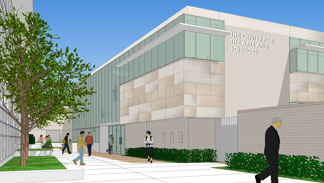Aquatic Facility Targets LEED Silver

SAN MATEO, Calif. — An educational building that opens out to a competition swimming pool is not the typical layout a person might expect to find in a high school setting.
But at the private Junipero Serra High School in San Mateo, Calif., the academic and aqua pairing is presently under construction as part of a four-phase master plan designed to upgrade the school’s facilities and programs, and to improve its outdoors spaces.
“It is kind of an unusual pairing — usually you don’t want athletics mixed with classrooms,” says Dan Wetherell, principal and director of business development at the Ratcliff architectural firm, in nearby Emeryville. ╥The facilities work well together in space and on paper. The main link between the two is the outdoor spaces. Given the limitations of the site we were able to make it work.╙
The $21 million Center for the Arts and Sciences and Aquatics Facility features a 24,000-square-foot classroom building, and a 38-meter by 25-yard pool. The center’s outdoor promenade links to the school’s drop-off site and parking garage, providing a main entrance to the campus and to the pool for swim competitions. An outdoor courtyard adjacent to the pool and academic building provides space for swim teams and social gatherings, as does a quad next to the center’s art room. Included in Phase One of the project, both are slated for completion by June 2011.

Designed to LEED Silver standards by Ratcliff, and being constructed by Hathaway Dinwiddie of San Francisco, the arts and science building will feature five science lecture laboratories; new facilities for school yearbook, newspaper and film production; and a large art room and new ceramics area. High-tech music and theater spaces include a band rehearsal and choral room, recording studio, and a green room.
When completed, the classroom building will be outfitted to handle smart board technology and wireless computer connectivity stations.
“Part of integrating all this technology allows the teachers to use different instructional pedagogies,” Wetherell says. “What we believe is key in good classroom design is flexibility — not every teacher wants to teach the same way. We tried to make the spaces large enough so teachers can be pretty flexible in them.?
Acoustical design was also important in a building that contains rooms for band rehearsal, science instruction, and painting — all side-by-side, says Wetherell.
Having a large building mass also contributes to the center’s green features, providing for passive solar heat gain ╤ or the ability to store heat within the walls and floors even though the sun isn’t shining. Other sustainable elements include a naturally daylit design and recycled building materials.
